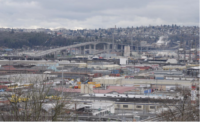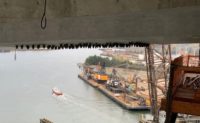Contractor Hired For First Phase of Seattle Bridge Fix

Contractors will fix a bulging bearing on Pier 18 of the West Seattle Bridge as the first step in determining whether the structure can be fully repaired. Image courtesy SDOT
A Seattle bridge closed due to worsening cracks in March will stay closed through at least 2021, according to the Seattle Dept. of Transportation. The agency says a contractor will fix a bulging bearing on Pier 18 of the cracking West Seattle Bridge before it can move forward and see if the 36-year-old bridge is salvageable.
Once the bearing gets repaired, SDOT will “add additional support to make sure the bridge does not crack under its own weight,” says Sam Zimbabwe, SDOT director. “Then we can understand what we need to do to shore up the bridge and repair it, and we don’t know yet if that is technically or financially feasible,” he says. “Each step will help us better understand what next step to take.”
Worsening cracks in the West Seattle Bridge, a 2,600-ft-long high-rise structure crossing the Duwamish River between West Seattle and Harbor Island, forced an emergency closure on March 23. Since that time, SDOT has installed around-the-clock monitoring and announced a plan to hire Kraemer North America to repair Pier 18.
The next phase of work to construct shoring to stabilize the bridge will require “unique equipment and materials that require fabrication,” Zimbabwe says. He doesn’t expect that work would be able get underway until late in 2020, but much of that phase’s work will be determined by how the first phase proceeds.
Taking vehicles off the bridge has slowed the cracking, but not stopped it. Fixing the bridge’s Pier 18 and shoring the bridge may bring clarity to a fixable solution, and SDOT says it hopes to understand possible scenarios with the help of a technical advisory panel of experts from around the country.
“There are a lot of contingencies we still don’t know yet on this project and we are not sure about the full cause,” says Seattle Mayor Jenny Durkan. “Fixing a bearing on Pier 18 will allow the bridge to flex and move, but we are uncertain what the data will show when we get that repaired. We don’t have a specific timeline and cost.”
SDOT warns that any potential fix would likely add only 10 years of life to the failing structure. The low bridge remains open only to transit, freight and emergency vehicles.
Seattle used emergency contracting authorization to select Kraemer for what is now deemed phase one of the West Seattle High-Rise Bridge stabilization. The first step was removing traffic and the second step in phase one is repairing lateral bearings on Pier 18, on the east side of the bridge.
The second phase will add temporary external structures to shore the bridge so experts can continue to assess repair feasibility, timeline and cots. The third phase, long-term repair, is not yet a certainty.
In the emergency contract, SDOT waived all competitive bidding requirements and contacted six contractors on April 13. Kraemer has recently worked on Washington State Dept. of Transportation's Duwamish River Bridges Project and has an understanding of the immediate vicinity, as well as US Coast Guard permitting requirements, SDOT says. The Kraemer northwest headquarters are located in Seattle. Under the agreement, Kraemer is working without a contract under a limited notice to proceed, says a SDOT spokesperson. Based on state law, work can begin before a contract is signed and a contract “will be negotiated in the very near future as the repair design advances.”
Kraemer will replace the lateral bearings on the east end of the bridge, bearings that allow the bridge to expand and contract with temperature and loading changes. The bearings—rectangular pieces of synthetic rubber neoprene—act like a cushion to separate the box girder from the column cap . The bearings at Pier 18 are currently compressed and bulging, restricting movement of the bridge and creating additional pressure on the surrounding area. “That bearing is not moving,” Zimbabwe says, “and is transferring stress through the bridge.”
SDOT expects to potentially take months to determine the best way to repair the bearings, which could include temporary platforms around the work area and specialized equipment to precision-demolish the concrete surrounding the bearing, place new bearings and pour new concrete. Kraemer will also provide a constructability review of the stabilization designs to determine how easily it can be built and provide input. Kraemer deferred comment to SDOT.
Currently work has started with the design team, which involves reviewing designs produced by WSP engineers under contract with SDOT. In addition, the project leads at Kraemer are starting to develop plans for construction, health and safety, equipment and material procurement, work timelines and schedules. “Construction will begin once the design has been completed, permits have been obtained and customized materials have been procured,” says a SDOT spokesperson.
SDOT has also announced plans for an emergency evacuation plan, if needed, in case of a greater bridge emergency.
If during Phase 1 engineers determine the bridge structure is irredeemably compromised, Phase 2 may still proceed so that temporary shoring prevents any potential failure while plans get made for demolition and replacement. SDOT also says that releasing Pier 18 bearings and temporary crack arrest measures may stabilize the bridge enough to that shoring isn’t needed if the city decides to move straight toward demolition.
The bridge has been monitored regularly since 2014. In 2019, the federal load rating for this type of bridge was changed, and SDOT initiated a new review. As a result, the transportation agency has regularly inspected concrete cracks.
The bridge was originally designed for three lanes of travel in each direction but was expanded to three westbound lanes and four eastbound. The added traffic, combined with the increased size and weight of commercial vehicles, has compounded the long-term maintenance challenge, the city says. Additionally, 80% of the load is dead load, so deterioration was possible even without traffic.




